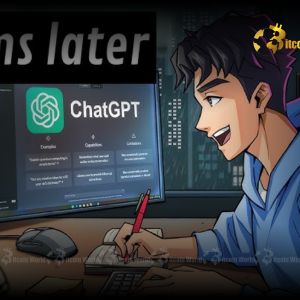ChatGPT Unveils Revolutionary ‘Study Together’ Feature for Education
6 min read
BitcoinWorld ChatGPT Unveils Revolutionary ‘Study Together’ Feature for Education In a world increasingly shaped by artificial intelligence, from predictive analytics in financial markets to groundbreaking developments in decentralized technologies, the evolution of tools like ChatGPT continues to captivate global attention. Just as blockchain promises to revolutionize finance, AI is poised to transform education. Recent whispers from the digital frontier suggest that OpenAI’s flagship chatbot is quietly rolling out a fascinating new feature: “Study Together.” This enigmatic addition hints at a profound shift in how AI interacts with learning, potentially reshaping the very fabric of academic engagement and raising intriguing questions for the future of digital collaboration. What is ChatGPT’s ‘Study Together’ Feature and Why Does it Matter? The tech community is abuzz with reports from select ChatGPT users who have spotted an intriguing new option in their toolkit: “Study Together.” This feature, still shrouded in mystery and unconfirmed by OpenAI, appears to be a deliberate step towards transforming the AI chatbot into a more sophisticated and interactive educational companion. Unlike its traditional role of directly providing answers, early indications suggest that “Study Together” aims to foster a deeper, more participatory learning experience. Imagine a scenario where instead of simply being given the solution to a complex problem, ChatGPT engages you in a Socratic dialogue, probing your understanding with insightful questions and guiding you towards self-discovery. This approach marks a significant departure from the passive information retrieval that often characterizes AI interactions, moving towards an active, human-centric learning paradigm. Initial user observations point to a mode where the AI prompts the user for answers, much like a seasoned tutor. This could be OpenAI’s strategic response to initiatives like Google’s LearnLM, which also focuses on AI-driven educational interactions. The core idea seems to be to encourage critical thinking and knowledge retention rather than rote memorization or quick answers. Furthermore, there’s speculation about a collaborative aspect – could “Study Together” evolve into a multi-human chat environment, allowing groups of students to study together with AI facilitation? This would open up unprecedented avenues for peer-to-peer learning augmented by intelligent guidance, creating dynamic virtual study groups that transcend geographical barriers. How is AI in Education Being Revolutionized by This Feature? The integration of AI in education is not new, but it has certainly been a double-edged sword. On one hand, tools like ChatGPT have proven invaluable for educators, assisting with everything from drafting lesson plans and creating quizzes to generating personalized learning materials. Students, too, have leveraged AI as a personal tutor, receiving instant explanations and feedback. However, the darker side has also emerged, with concerns about academic integrity and the ease with which students can use AI to complete assignments without genuine understanding. The rise of AI-generated essays has sparked intense debate, with some commentators even suggesting that advanced AI could fundamentally undermine traditional higher education models. The ‘Study Together’ feature, if fully implemented as envisioned, could represent a pivotal moment in this ongoing evolution. By shifting the AI’s role from answer-provider to question-asker and facilitator, OpenAI appears to be directly addressing the challenge of responsible AI use in academia. This new mode could actively discourage ‘cheating’ by making it harder to simply copy-paste solutions. Instead, it would compel students to engage with the material, articulate their thoughts, and defend their reasoning. This pedagogical shift could empower students to develop deeper comprehension and critical thinking skills, transforming AI from a potential shortcut into a genuine learning partner. The implications for personalized learning paths, adaptive assessments, and even remedial education are vast, promising a more effective and equitable learning landscape for all. How Will ‘ Study Together ‘ Potentially Work? Unpacking the Mechanics While OpenAI remains tight-lipped, the reported functionalities of ‘Study Together’ offer clues into its potential mechanics. The primary observed shift is the AI’s tendency to ask questions rather than provide direct answers. This Socratic method, long lauded in educational theory, encourages active recall and critical thinking. Here’s a speculative breakdown of how this mode might operate: Socratic Questioning: Instead of responding to ‘Explain quantum physics,’ the AI might ask, ‘What are the fundamental principles of quantum mechanics?’ or ‘How does wave-particle duality manifest in real-world phenomena?’ Guided Discovery: If a user struggles, the AI might offer hints, break down complex concepts into smaller parts, or suggest resources, rather than simply giving the answer. Error Correction and Feedback: When a user provides an incorrect answer, the AI could gently guide them towards the correct understanding, explaining the flaws in their reasoning without explicitly stating the right answer. Progress Tracking: The system might track a user’s understanding of various topics, identifying areas of weakness and suggesting targeted practice. Collaborative Mode (Speculated): If a multi-human study group feature materializes, the AI could act as a moderator, posing questions to the group, summarizing discussions, or even facilitating debates on complex topics, ensuring all participants are engaged and learning effectively. This interactive approach contrasts sharply with the traditional search engine model, where information is retrieved passively. ‘Study Together’ appears designed to make the human user an active participant in the knowledge construction process, making learning more robust and durable. This proactive engagement is crucial for developing genuine mastery, not just surface-level understanding. What is OpenAI’s Vision for the Future of Learning? The development of ‘Study Together’ aligns with a broader vision from OpenAI : to create AI that not only understands and generates human-like text but also genuinely augments human intelligence and capabilities. This feature signifies a strategic move to position ChatGPT not just as a powerful language model, but as a sophisticated educational assistant that promotes deeper learning and critical engagement. By encouraging users to formulate their own answers and grapple with concepts, OpenAI is fostering a more robust learning environment, moving away from a reliance on AI as a simple answer machine. This initiative also speaks to OpenAI’s commitment to responsible AI development. Recognizing the ethical dilemmas posed by AI in academic settings, ‘Study Together’ offers a potential solution by steering users towards productive and ethical engagement. It’s a proactive step to ensure AI serves as a tool for intellectual growth rather than a means to circumvent genuine learning. The long-term implications for skill development, lifelong learning, and professional training are immense. Imagine bespoke learning modules tailored precisely to an individual’s learning style and pace, guided by an AI that understands not just the content, but the learner’s cognitive process. This is the future OpenAI appears to be building, where AI becomes a ubiquitous and beneficial partner in human intellectual pursuits. What Broader Impact Will This Have on EdTech ? The emergence of features like ‘Study Together’ will undoubtedly send ripples through the entire EdTech industry. Companies currently offering AI-powered tutoring or learning platforms will need to innovate rapidly to keep pace with OpenAI’s advancements. This new mode could set a higher standard for interactive learning, pushing the boundaries of what’s possible with AI in educational contexts. We might see a surge in platforms adopting similar Socratic or collaborative AI models, moving away from simple content delivery to more engaging, dialogue-based learning experiences. Furthermore, the success of ‘Study Together’ could influence how AI is perceived and utilized across various sectors. If AI can effectively facilitate deep learning and critical thinking, its applications could extend to corporate training, skill development, and even personal growth initiatives. It could democratize access to high-quality, personalized education, making advanced learning resources available to a much wider audience globally. The challenge for EdTech companies will be to integrate these advanced AI capabilities seamlessly and ethically, ensuring they complement human instruction rather than replace it. This evolution underscores a critical shift: AI is no longer just a tool for automation, but a dynamic partner in human development and knowledge acquisition. The quiet rollout of ChatGPT’s ‘Study Together’ feature marks a potentially transformative moment for artificial intelligence in education. By shifting the AI’s role from a simple answer engine to a proactive, question-asking facilitator, OpenAI is aiming to cultivate deeper understanding, critical thinking, and responsible academic engagement. While still in its early stages and shrouded in some mystery, this innovation promises to reshape how students learn and how educators leverage AI tools. It represents a proactive step towards mitigating the challenges of AI-assisted cheating while amplifying its immense potential as a personalized learning companion. As AI continues to evolve, features like ‘Study Together’ demonstrate a growing commitment to harnessing its power for genuine human intellectual growth, ensuring that technology truly serves as an empowering force in the pursuit of knowledge. To learn more about the latest AI in education trends, explore our article on key developments shaping AI features and institutional adoption. This post ChatGPT Unveils Revolutionary ‘Study Together’ Feature for Education first appeared on BitcoinWorld and is written by Editorial Team

Source: Bitcoin World



